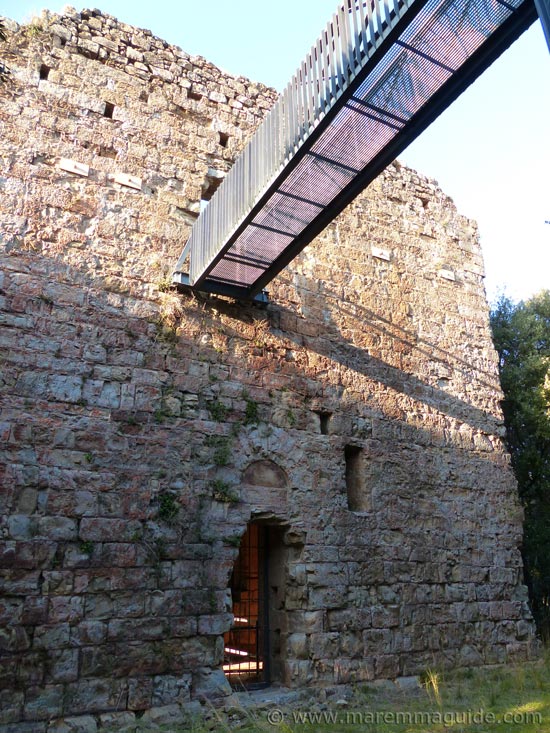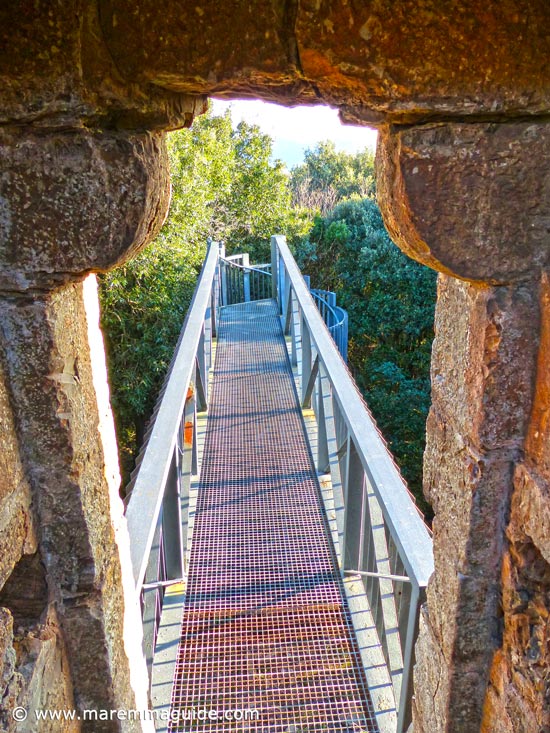The Pievaccia in the Parco di Montioni
A fortified Knights Templar church in Maremma?
The remains of the "la Pievaccia" fortified church in the woods of the Parco Naturale di Montioni might not look like much nowadays, yet this tower is the site of two unsolved mysteries and, as any of you who have read some of my other pages in my guide to Maremma know, I love mysteries (and castles and towers and...)
But these aren't just any kind of mysteries. We are talking the Knights Templar and a whole missing medieval village. :)
Maremma is a perfect place for children with huge imaginations. You need big imaginations, because in many cases there isn't that much physically left to see. But children have loads and all you need to do is sow the seed with the tales and legends before you arrive and you can have happy families for hours in the middle of nowhere. Fun on a budget.

I often say this about Maremma in general and about favourite places of mine that I recommend that you visit: there are no bells and whistles, theme park attractions, or anything similar. And that is even more true about the tower of Pievaccia.
What you will find is a tower from the high middle ages - partly restored to stop it falling to the ground - with an external wrought-iron staircase and tree-top walkway giving you access to its upper level and a view. Nothing else. Nothing. So if that is your sort of thing, great.
Take a picnic. Enjoy the walk through the woodland for what it is, a walk through a nature reserve.
Hear the rustling in the undergrowth and trees as you pass.
Spot the tracks and quickly become an "expert" wild boar or wolf tracker :) Yes, there are tracks of the latter too! The local deer population hasn't dwindled for any other reason of late!
Revel in there being no one else around for miles and miles. In the silence. The views. All reachable, but hardly known about, from the hustle and bustle of Follonica in the summer.
Your photographs of the trip more than likely won't impress your friends back home because they won't be of picture postcard Tuscany. But you will have "discovered" a medieval tower. One protecting a now lost village in Tuscany that no one else but a very few have or will ever visit. Locals born here or tourists.
And if little things like that, nature and mysteries are what you like, then visit Pievaccia and share your photos with me.

Originally the building had two floors. The upper floor comprised of a single room with an at one time very rare type of vaulted roof - a "spezzata" - reaching a height of seven metres.
The vault probably collapsed during the biggest earthquake to hit Maremma on 11 December 1724. It reached a magnitude of between 7 and 8 on the Mercalli-Cancani-Sieberg seismic intensity scale.
If you didn't already know, Maremma is seismically active and home to a geothermal field with current day characteristics of up to five low to moderate seimicity events a day. It is called the Larderello-Travale Geothermal Field (LTGF) and is home to the oldest geothermal power plant in the world. Tthe maximum intensity earthquake ever experienced in Maremma was that of 1724 in the Travale zone.
The collapse of the upper vault broke that of the ground floor and caused the huge cracks that you can see today on the front and back walls.
There are no surviving documents that tell of its construction or story, but it is thought to date to the thirteenth century. With walls built in blocks of stone, 1.2 metres thick in the lower section and one metre thick in the upper, it's purpose was in all likelihood that of a combined place of worship and defence. In the centre of a village.

And this is where it gets interesting, for its architectural and constructional characteristics suggest that it was built by the Knights Templar, who were present in Tuscany until their violent suppression at the beginning of the fourteenth century.
Tuscany was one of the wealthiest and most advanced economies in the western Christendom, and the trade routes between East and West passed through it, as did the pilgrimage routes to Rome and the Adriatic ports for embarkation to the East. From the receipt of their first donation in Tuscany in 1138, the Knights Templar built an impressive network of receiving houses connecting the cities of Firenze, Siena, Pisa and the coast.
Routes to Maremma's rich metalliferous hills and the coast from Firenze to Poggibonsi and San Gimignano converged with those from Siena at Frossini, north of Massa Marittima.
Of the verified eleven Templar buildings in Tuscany, four are in the Maremma Grossetana area: the Church of Mercy in Grosseto, the Magione of San Salvatore in Grosseto, the Pieve di Santa Cristina and Ospedaletto in Rochette Fazio, and the Pieve Santa Mustiola at Sticciano, only about 38 kilometres away.
But many more places in Maremma and Tuscany are considered to be of Templar origin. Local legends and the symbolism still visible today above doors and on walls more than just suggest it, but the concrete evidence for many of the sites is lacking. So far that is.
But there is evidence that the Maremma coast was guarded by the Templars, who also controlled the traffic to the mines inland. Rich mines that extracted copper and silver for coinage, alum for wool production, and mercury for use as both a dye and in the extraction of gold and silver from ore. As well as the trade in Maremma saffron and grain.
And the Pievaccia is perfectly lined up between the once wealthy and very important mining city of Massa Marittima in the metalliferous hills and the Isola d'Elba - home to more mines (iron) - with close access to what would have been the only coastal route and a sweeping view of the whole of the Gulfo di Follonica.
No one knows why it is called the Pievaccia and it is not known to whom the church was originally dedicated.
It was was restored in 1996 by the Comune of Follonica with money from the EEC and the Regione Toscana. The conservation works comprised of repairing the building to the point at which it was first discovered, without any additional hypothesised reconstructions. The lower floor vault ceiling was repaired and the collapsed sections of walls plastered.
The upper floor was probably originally reached by a wooden staircase, but today you will need to take the wrought iron one built to the right of the building next to the well.
 The "tardis" wrought iron staircase that you will need to climb ... (I don't like heights and it is always worse for me when you can see down through the steps!)
The "tardis" wrought iron staircase that you will need to climb ... (I don't like heights and it is always worse for me when you can see down through the steps!)
The view down from the walkway and the grate covered well that is the only remaining evidence of the village that once surrounded the church.

The tree-top walkway in.

The entrance today.

The side walls of the upper vault are evident when you reach the top.
And although you have to imagine what its ceiling would have looked like, its absence means that at tree-top height you can gaze at a ceiling of blue sky, a panoramic scenery that sweeps across the metalliferous hills all the way to the two promontories of the Punta Ala and Piombino, and out to sea to the island of Montecristo and the sunset behind the Island of Elba.
 This is my family in the photo and that's my shadow! I am tall, but not that tall!
This is my family in the photo and that's my shadow! I am tall, but not that tall!
The view across the Valle del Pecora - the Valley of Sheep - to the sea from the top. If it was a look out tower or link in a communication chain from inland to the Island of Elba and along the coast, then it was strategically placed.

At the present time, you can't access inside.
 Internally, the Pievaccia measures 8.70 metres by 4.80 metres.
Internally, the Pievaccia measures 8.70 metres by 4.80 metres.
Although it obvious that some restoration work was a while ago - without the cement filler in the huge cracks in the front wall the whole thing would have come tumbling down a long time ago - the tower is still in need of some tender loving care. The tree growing out of the upper part of the eastern wall at a minimum needs to be removed before its roots do any more damage to the stonework.

The route to Pievaccia

There are two routes to "la Pievaccia": a long one and a not so long one!
The first is entirely on foot from the village of Montioni. The route is the Montioni-Follonica "sentiero" (footpath) that is a medium going 13 kilometre trek that will take you about 4 hours 30 mins to 5 hours to complete, up and down two hills of 247 metre and 261 metres high. The Pievaccia is about half way along the route.
The second - and much easier! route - is accessed from along the Massa Marittima to Follonica road. From here it is possible to drive along a single un-tarmacked track into Montioni Natural Park. The track has lots of pot holes, but it is passable with a normal car with care. Alternatively, you can park your car at the marker point Number 1 on the map and walk along this part of the track.
You will pass an opening with old charcoal burners on your left. Continue until you reach a second open area - marker number 2 on the map - where you will see signs for the Pievaccia. (There were two when I visited.) You can park here, and then walk up the hill.
From here the route is easy going - the photo above is us on our way down. Just watch your footing coming down the hill. But be aware if you have little ones with you, that it is still a decent - about a kilometre - walk to the tower. And it is stony ground all the way, so for your ankles, a pair of walking/trainer shoes are best.
Are we there yet?
You will know that you are about half way there when the doubters amongst you start asking if you are sure the Pievaccia is here, and you will be about three-quarters of the way there when they ask again!
As is the case with most medieval castles and towers I have explored in Maremma, they are built on the highest point, and that is where you will find this "torre" (tower), on the right behind Mediterranean macchia bushes, just as you reach the summit. If you start to descend, even ever so slightly, you have passed it! But you will see it.
Whichever route you choose, take water with you - even in the winter - as you will need it and there are no bars or restaurants in this wilderness :)
And be prepared to carry all of your outer layer clothing and those of your children as the climb up the hill will warm you up!
There are new picnic tables sat under the trees surrounding the tower - offering plenty of shade for when you get there - the ground around them all well rooted by wild boar.
Read about...
Read about the Parco Naturale di Montioni, everything you could possibly want to know about the wild boar that live there and like to visit at dusk the hamlet of Montioni.
Explore some more...



















